
THOMAS SULLY – A BLUE PLAQUE has been erected in Horncastle on a wall outside the Co-op Store on Conging Street
Thomas Sully
Born in Horncastle, June 1783
Became a Renowned Portrait Artist in America
Died 5 November 1872. Philadelphia USA.
Talk on his life and times was given by Colin Gascoyne at the Admiral Rodney Hotel on 15th January 2020
A follow up talk focussing on his work, due for 15th July, has been postponed due to Coronavirus
Thomas Sully was born in Horncastle and became one of the finest portrait painters in America. In 1835 he was elected a Member of the American Philosophical Society, his citation describing him as "one of the most distinguished painters of the United States”.

Self-Portrait of the Artist Painting His Wife, Sarah Sully
c.1810. Yale University Art Gallery
Thomas Sully was born in Horncastle in June 1783. His parents, Matthew and Sarah, were actors who toured and played the provincial theatres. It is thought they came to Horncastle that summer to present their plays. A barn-cum- theatre in Dog Kennel Yard may have been the venue for their performances.
In 1792 the Sully family emigrated to America, settling in Richmond, Virginia, and later in Charleston, South Carolina. All the family made careers on stage. Thomas made at least one appearance in 1794, in the Charleston Theatre. At 16, after a very brief career in an insurance office, Thomas determined to become an artist.
Thomas started by painting miniatures in watercolour and progressed to oil paintings. From 1801 to 1872 he produced over 2600 paintings – 2,000 and more were portraits, 65 were miniatures, and 500+ were subject or "fancy pictures", as he called them.
Sully was said to be at his best when portraying prominent society women. As the magazine Godey's Lady's Book proclaimed in 1844 "Sully, as all the world knows, paints exquisitely beautiful portraits of ladies. His praise is in all the parlours".
For all his fame, Thomas was first and foremost a family man, a devoted husband and father who worked tirelessly to support his family.
Thomas died at his home in Philadelphia on November 5, 1872, "honoured and loved by all who knew him ... at a good old age full of years and honours". He is described by his contemporary, William Dunlap as "walking with the stride of a man of six feet, though he was not over five feet six inches in height" and as having a face "marked with the wish to make others happy". His whole life was characterized not only by great consideration for others but by the utmost fairness and honesty.
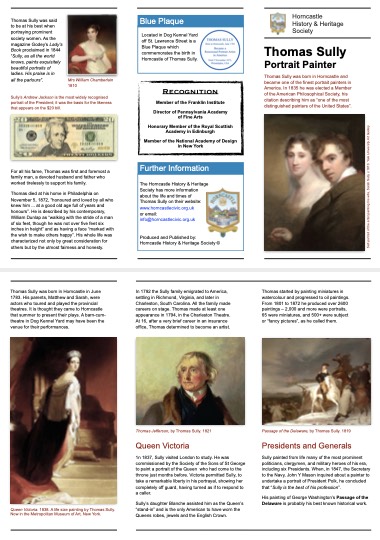 | |
| Download the "Thomas Sully leaflet.pdf" |
To view some of her work from the Royal Collection visit the "Explore the Royal Collection online" website.
A Blue Plaque was erected on her former home at 40 East Street, Horncastle on Saturday 14th July 2018 to commemorate the life of this remarkable woman. It was unveiled by the Society's Patron, Francis Dymoke. He pointed out that it is especially appropriate as 2018 is the year we acknowledge women's achievements. This is the first plaque for a woman in the town. A full file on her life and works is now available at the town archives.
A leaflet has been produced and is available at the library and the Tourist information centre. All portraits are reproduced by kind permission of the Royal Collection Trust @ Her Majesty Queen Elizabeth II 2018.
Below is an extract from the text of the leaflet ommitting portraits:
ANNIE DIXON
1817- 1901
Annie was one of Britain’s most successful and productive 19th century female miniature portrait painters. Active from around 1840 to 1893, Annie is reputed to have painted over one thousand portraits, 222 of which were exhibited at the Royal Academy. Annie was a favourite of Queen Victoria, and from 1859 she painted portraits of most of the Royal Family, especially the Queen’s children and grandchildren. More than 20 of Annie’s paintings are now with the Royal Collection.
Annie was born in Horncastle 12 March 1817 to parents William and Susanna. She had three brothers and four sisters, her father was a corn merchant. From about 1855 the family home was 40, East Street, Horncastle, which is now identified with a Blue Plaque in commemoration of Annie.
Annie early developed a love for water colour painting and was gifted with an ability in obtaining a likeness. Early in her career she painted a miniature of Harriett Anne Palmer of Horncastle and another of George Harwood Browne a farmer and landowner of Farforth near Horncastle. She worked in Hull with Ann Cooke, thought to be the first woman commercial photographer in Britain. Annie was instructed in miniature painting by Mrs. Magdalen Dalton the sister of Sir William Ross who, from 1845 onward, had been commissioned by Queen Victoria to paint miniatures of each of her children. In 1857 Sir William suffered a stroke and was not able to paint again. The Queen chose Annie Dixon to complete the work. Such was the satisfaction with her work, further commissions from the Royal family followed and she was in great demand from many nobles and eminent people. It is a testament to her skill and dedication to her work that she prospered when many other portrait painters suffered from competition with the new art of photography.
With her work Annie went to the Royal residences Sandringham, Osborne House, Claremont and many fine country houses but she made time to be with her family in Horncastle also at her London home where she was usually joined by her sisters, nieces and nephews. When at Sandringham she would often visit and stay with relatives, the Bennett family, in Kings Lynn.
Annie was 76 years old when she last exhibited at the Royal Academy; failing eyesight prevented her from continuing the art she so dearly loved. Annie died at her home, 90 Eaton Terrace, Belgravia. London, 12th February 1901. She chose to be buried in Horncastle and on 15th February her remains were conveyed by train to Horncastle and interred in the cemetery. Her grave can be found to the right rear of the chapel adjacent to that of her sisters Frances and Emily
Produced and Published by Horncastle History & Heritage Society. ©
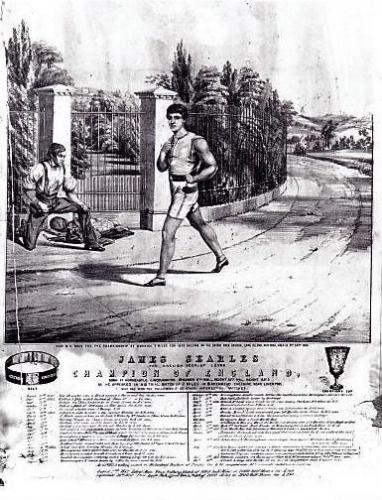 |
James Searles was born James Belton in Horncastle on 26th December 1819. He took the name Searles after his parents married. He appears to be an all round athlete, becoming Champion of England at Boxing for which his nickname was Tigser. He was equally well known as a runner and was known as (the English Deer). He raced in America. Records show he ran 20 & 10 mile races as well as 250 hurdles. He was also thought to be a jockey. We are still compiling information on James and will add as available. |
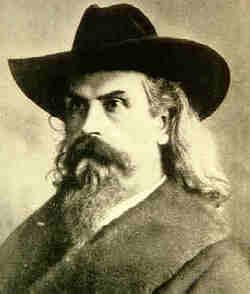
Fighting alongside William the Conqueror at the Battle of Hastings was his staunch defender, the Champion of the Dukes of Normandy, Sir Robert Marmion. The Manor of Scrivelsby was assigned to Sir Robert, as the King's Champion, thus heralding the beginning of this hereditary title that continues to this day.
Scrivelsby Court in the early 20th Century. It was demolished in 1956.
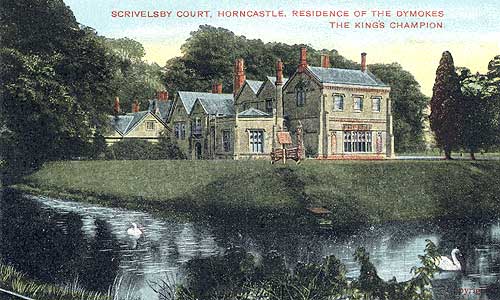
On the winding and picturesque road between Horncastle and Revesby lies the estate and park of Scrivelsby Court. Sheep and herds of red deer peacefully graze on the lands that have been associated with the King's (and Queen's) Champion for over 900 years.
Fighting alongside William the Conqueror at the Battle of Hastings was his staunch defender, the Champion of the Dukes of Normandy, Sir Robert Marmion. Following the successful conquest, Sir Robert became the first King's Champion who would fight for the monarch's right to rule over England against any who dared to challenge. For his service as Champion at coronations, the Manor of Scrivelsby was assigned to Sir Robert, thus heralding the beginning of this hereditary title that continues to this day.
The Marmion family retained this title and duty until the death of Philip Marmion in 1292 who had four daughters but no male heirs. This left a void until 1350 when Philip's great grand daughter, Margaret, married Sir John Dymoke who then took up residence at Scrivelsby. Despite a challenge from another descendant Sir John successfully claimed the office of Champion and later performed his duty at the coronation of Richard II in 1377. The procedure and scene in the Great Hall of Westminster must have been splendid to witness.
The first to enter were two knights on horseback bearing the Champion's spear and shield followed by the Champion in a shining full suit of armour with a plume of feathers in his helmet. He was mounted on a richly decorated white horse that he had chosen from the King's Stables. At his side, also on horseback, were his escorts, the Earl Marshal and the Lord High Constable.
Following a trumpet blast, the York Herald read out the proclamation of challenge to anyone who denied the sovereign his right to the throne. The Champion then threw down his gauntlet to challenge any dissenter to mortal combat. After the third time the proclamation was read, and the gauntlet thrown, with no challengers stepping forward, the King was presented with a gold cup full of wine. The King then drank to the Champion and passed the cup to him. The Champion finished the drink and shouted "Long Live your Majesties" before withdrawing backwards. The cup was kept by the Champion as a fee for his services.
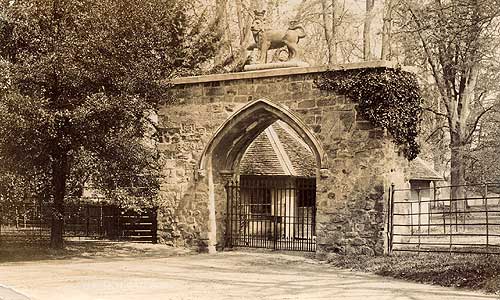 |
Lion Gateway to the estates built c.1530 by Sir Robert Dymoke, still standing today |
Down the centuries the monarchy came under threat and the encumbent Dymoke Champion had to make a stance. During the War of the Roses, Thomas Dymoke supported the Lancastrians which led to his beheading by the order of Edward IV. When the Civil War erupted, Charles Dymoke naturally supported the monarchy, even leaving £2,000 on his death to the king. Regrettably, for the family, the Parliamentarians seized power resulting in Edward Dymoke being fined the vast sum of £7,000 for bearing the "lewd and malicious title of King's Champion".
Although he was reinstated at the coronation of Charles II and knighted for "his loyalty and great sufferings both in person and estate", the family fortunes had been decimated. Despite this the Dymokes retained the Scrivelsby estates finally acheiving financial stability again in the 19th century thanks to the efforts of Sir Henry Dymoke.
The full ceremony, in all its glory, was last performed in 1821 when Sir Henry Dymoke acted as Champion at the coronation of George IV. Since Richard II, in 1377, there has been a Dymoke officiating at the coronations of 25 Kings and Queens of England. The present Honourable Queens Champion, Colonel John Marmion Dymoke MBE, was present in his office at the coronation of Queen Elizabeth II in 1953.
Magnificent suits of armour from Scrivelsby Court can be seen at the Tower of London.
The information above was taken from articles written by H. D. Martineau
and Peter Wilkes who we thank and give full credit to.
Edward Harrison studied in Edinburgh, and then in London under the Hunter brothers – John Hunter (1728-1793) and William Hunter (1718-1783). He obtained his doctorate at Edinburgh in 1784, visited Paris, and subsequently practiced for thirty years in Horncastle in Lincolnshire, where he founded, among other things, a dispensary, the Medical Society of Horncastle, and the Lincolnshire Benevolent Medical Society. He also established a charitable spinal infirmary in London in 1837.
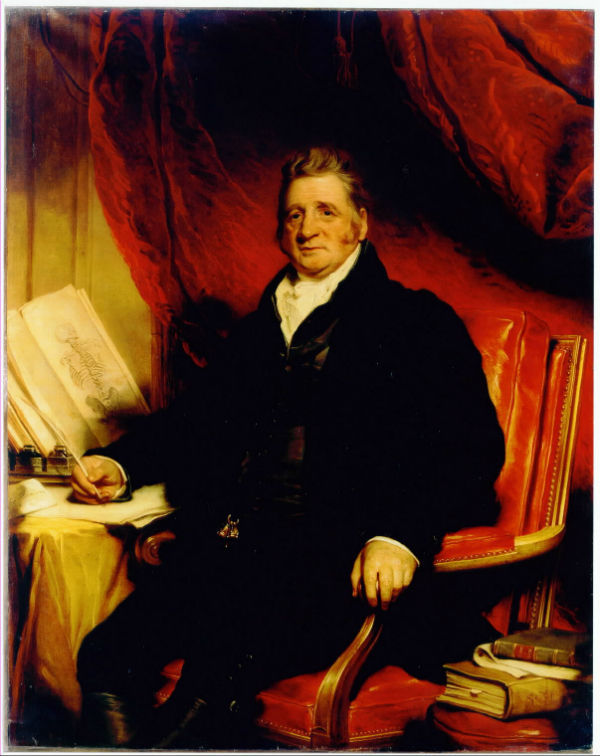
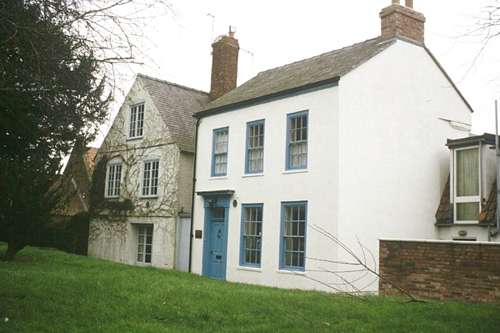
In December 1789 the citizens of Horncastle welcomed the opening of Lincolnshire's first Dispensary at No.2, St. Mary's Churchyard. This was the first of many beneficial projects instigated by the world famous botanist, Sir Joseph Banks.
The two original physicians employed were Edmund Laycock, who retired within a year; and Edward Harrison who was to devote 32 years to his vocation in Horncastle. During his working life, of almost 50 years, his efforts and his methods of practise became known throughout the United Kingdom and the world at large. He became the subject of adulation, ridicule and controversy which still continues to this day!
Alongside his care to the sick and infirm, he was determined to implement a Medical Reform bill through parliament to regulate the licensing of medical practitioners in every sphere of medicine. This was prompted by the vast amount of unregulated "quacks" who were doing immeasurable harm to the public. With the support of his friend, and patient, Sir Joseph Banks, his crusade was to last 12 years, before being defeated by the Royal College of Physicians in London, who feared they would lose some of their power and influence.
Despite this set back to his ambitions, he expanded his interests by caring for the insane in his private asylum at 30 West Street, Horncastle. He also nurtured the talents of young medical graduates, the most notable being E.P.Charlesworth who later diligently served for 33 years at the Lincoln Asylum. Harrison also became the highly regarded physician to the father and uncle of Alfred, Lord Tennyson, at nearby Somersby.
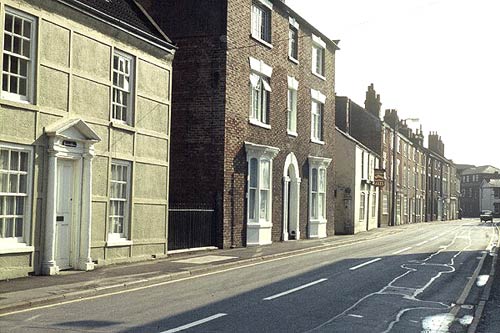
(The house is in the centre of the picture)
In 1817 his wife Margaret died, resulting in Harrison making preparations for his retirement from medicine. These plans were cancelled the following year when he wed his second wife, Charlotte Chaplin, from Tathwell Hall. Her cousin was suffering from a spinal deformity which roused the compassion and curiosity of Harrison. He developed a new method involving the massage and manipulation of individual vertebrae that he concentrated on for the rest of his life, and lead to his world wide fame, or notoriety. He cured Charlotte's cousin within a year, enabling her to return to the social activities that she had previously abandoned, due to her discomfort.
Harrison resigned from the Dispensary in 1821 to pursue and promote his new cure in London, by which time over 10,000 patients from all over the county had received treatment in this small market town.
His remaining 17 years in London were to bring even more conflict with the Royal College of Physicians, who took him to court for practising without their license. Harrison went on to cure patients with extreme deformities and restore the use of previously paralysed limbs. His attempts to promote his new method within the more conservative and staid medical community was generally met with scorn and derision.
His ambition to open a Spinal Infirmary charity for the poor was achieved in 1837, one year before his death, at the age of 78. Casts of his patient's backs, before and after his treatment, were distributed throughout the world to practitioners who admired his methods.
Harrison was buried in Horncastle not far from the Dispensary and a white marble memorial commissioned in St. Mary's church. A further memorial plaque was positioned above the entrance to the second Dispensary in North Street built in 1866. His charitable infirmary in London was to continue for at least a further 30 years after his death, during which time they treated a patient referred by Queen Victoria.
Harrison's methods formed the foundation of the modern Chiropractor.

- A biography of Edward Harrison is being contemplated, details of which will appear on this site, should it come to fruition.
- A book has been published on Harrison's life and times entitled "A Victory Over Prejudice" details of which can be found on
 www.edwardharrison.net
www.edwardharrison.net
Donations from sales will be given to the Civic Society.
- This is an article about Edward Harrison which was submitted to the Horncastle News in July 2007. Please click here -
 HarrisonArticle.pdf to download the PDF document to your own computer.
HarrisonArticle.pdf to download the PDF document to your own computer.
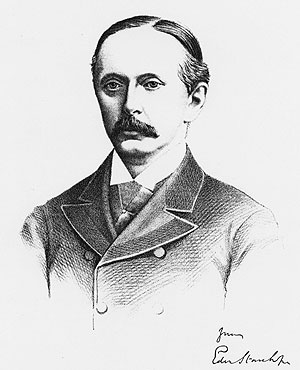 By a somewhat convoluted sequence of events, Edward Stanhope, born in London, became a respected benefactor to Horncastle and its people.
By a somewhat convoluted sequence of events, Edward Stanhope, born in London, became a respected benefactor to Horncastle and its people.
The lordship of the Manor of Horncastle had been held by the various Bishops of Carlisle since 1229 and leased to the grandfather of Sir Joseph Banks in 1714. This was inherited by Sir Joseph and upon his death in 1820 the title passed onto his wife, thereafter the lease was inherited by the Stanhope family.
During the time that James Banks Stanhope held the lease he took the opportunity to purchase it when the see of Carlisle relinquished ownership of the title in 1856. The estates and Lordship of the Manor of Horncastle were inherited, from his cousin, by Edward Stanhope in 1885.
Edward Stanhope was educated at Harrow School and Christ Church, Oxford where he studied law. In 1874 he was elected as the conservative Member of Parliament for Mid Lincolnshire. This constituency was abolished in 1885 and Stanhope became MP for the new constituency of Horncastle. During his nineteen years in Parliament Stanhope held many important offices including Under Secretary of State for India, President of the Board of Trade, the Secretary of State for the Colonies and Secretary of State for War.
In an act of generosity, Stanhope offered the Market Place, The Wong, the Pig Market and their respective revenue in tolls to the Local Board of Health for the benefit of the people of Horncastle. At a public meeting in 1892 the people passed a resolution accepting the valuable gift that had been in private hands for nearly seven centuries. Around this time the old buildings that stood on the Market Place were demolished leaving us with the clear area we see today.
When Stanhope died of a heart attack in 1893 a memorial was erected in the Market Place leaving us with a permanent reminder of his generosity towards the town and its people.

Early photograph of the Stanhope Memorial -- Sellwood House in background

High Street, Horncastle
Note the sunblinds and thatched roofs of the shops on
the right which were demolished to form the present
open space of the Market Place

Market buildings in 1890 - soon to be demolished
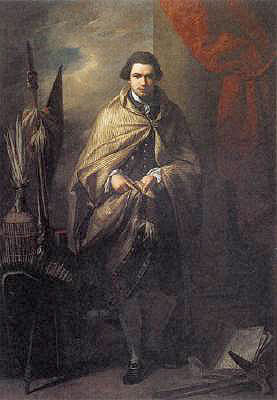 Sir Joseph Banks British explorer and naturalist who, as long-time president of the Royal Society, London, became known for his promotion of science.
Sir Joseph Banks British explorer and naturalist who, as long-time president of the Royal Society, London, became known for his promotion of science.
Joseph Banks studied at Oxford from 1760 to 1763, during which time he inherited a considerable fortune. After graduating, he travelled to Newfoundland and Labrador in 1766, collecting plant and other specimens.
In 1768 he led the Royal Society delegation on a voyage around the world with Captain James Cook, during which time they landed in New Zealand, at Poverty Bay, in 1769. While there, Banks described a great number of plants found in the area and wrote detailed descriptions of the Maori people who lived there.
His scientific account of the voyage and its discoveries sparked considerable interest in Europe, encouraging European settlement near the Pacific islands.
Horncastle Connection
Although the achievements of Banks are widely acknowledged, both nationally and internationally, his affection for, and contributions to his home town of Horncastle is less well appreciated.
Through his endeavours the foundations were laid that would lead to the improved health, well being and prosperity to the people and businesses in and around Horncastle.
Sir Joseph Banks was the driving force behind:-
- The drainage of the Wildmore Fens to the south of Horncastle leading to the reclamation of fertile land for farming.
- The formation, and patronage, of Lincolnshire's first dispensary, in Horncastle, supplying medical treatment to the poor. This included free vaccinations against small pox.
- Annual fund raising balls, on behalf of the dispensary, held at the assembly rooms of the Bull Hotel.
- Replacing the Open Field system with Land Enclosure resulting in greater opportunities for individuals and families to farm and build houses on their own land.
- The establishment, patronage and construction of the Horncastle Navigation canal opening a trade route to the River Witham and beyond.
- The formation and patronage of the Medical Society of Horncastle and the Lincolnshire Benevolent Medical Society.
- Edward Harrison's crusade to bring about Medical Reform through a Parliamentary bill.
- The formation and patronage of the first British School in Horncastle built on his land with trees he supplied from Revesby Abbey.
Affectionately known by locals as "Cousin Joe", Banks dedicated much of his valuable time to the welfare and prosperity of the Horncastle townsfolk.
Until recently, the only trace of Banks in Horncastle is his Town House in the High Street adorned with a commemorative Blue Plaque.
But now, mainly due to the vision and determination of Paul Scott and Jean Burton, the Sir Joseph Banks Society and Sir Joseph Banks Centre are being established and opened here in his home town.
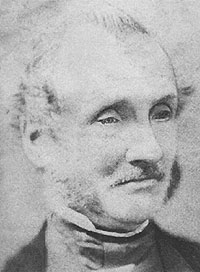 William Marwood (1820–1883), a cobbler, of Church Lane, Horncastle, Lincolnshire, England at the age of 54 persuaded the governor of Lincoln prison to allow him to conduct an execution.
William Marwood (1820–1883), a cobbler, of Church Lane, Horncastle, Lincolnshire, England at the age of 54 persuaded the governor of Lincoln prison to allow him to conduct an execution.
The efficient way in which he conducted the hanging of William Frederick Harry (or Horry) without a hitch on 1 April 1872 assisted him in being appointed hangman by the Sheriffs of London and Middlesex, for which he was paid a retainer of £20 a year plus £10 per execution.
Marwood developed the "long drop" technique of hanging, which ensured that the prisoners' neck was broken instantly at the end of the drop, resulting in the prisoner dying of asphyxia while unconscious. This was undoubtedly kinder than the slow death by strangulation caused by the "short drop" method, which was particularly distressing to prison governors and staff who were required to witness executions at a close distance following the abolition of public executions in 1868.
In his nine years as a hangman, Marwood executed 178 people, including:
- Charles Peace, the archetypal Victorian burglar and murderer, whose name struck terror in the hearts of everyone at the time. Hanged at Armley Jail, Leeds, Yorkshire, on 25 February 1879.
- Kate Webster, an Irish servant girl who murdered her mistress with an axe. Hanged at Wandsworth Prison, London, on 29 July 1879.
- Percy Lefroy Mapleton, who murdered Isaac Frederick Gold on a train between London and Brighton for his watch and some coins. Mapleton was arrested almost immediately, but escaped before being arrested again, convicted, and hanged on 29 November 1881.
- Joe Brady and four other members of the Irish National Invincibles gang who murdered Lord Frederick Cavendish, the Chief Secretary for Ireland, and Thomas Henry Burke, the Permanent Undersecretary for Ireland, with surgical knives in Dublin's Phoenix Park. They were hanged at Dublin's Kilmainham Jail in 1883.
In Marwood's time there was a popular rhyme which went:
If Pa killed Ma
Who'd kill Pa?
Marwood.
This is a letter written by William Marwood on Saturday 10th April 1875
 |
 |
| (click thumbnail to enlarge) | |
William Marwood's Executions
Compiled by Robert Pendell
William Marwood was an Executioner from 1872, becoming the official Crown Executioner in 1874 through to his death in September 1883. His main occupation was as a cobbler, his shop and home he shared with his wife Ellen still exist in Horncastle today.
Although poorly educated he devised a more humane method of execution resulting in a quick end, in contrast to his predecessor William Calcraft, who lacked his compassion and strong religious beliefs. He enjoyed his fame, or notoriety, and was no doubt delighted to receive an invitation from Madame Tussauds to attend sittings, enabling them to reproduce his likeness for their Chamber of Horrors.
What follows is a list of all the people he executed, ages, dates and prison locations, illustrating the extent of his travels and to remind us of the personal tragedies he confronted on a regular basis. Every individual who faced Marwood in their last seconds undoubtedly had a tale to tell. What were their upbringings like, what hardships did they face, what were their needs and aspirations? When we take into account the comparatively unsophisticated policing methods of the day, we can perhaps pose the question, were some of his "victims" innocent?
Whatever the circumstances, the law dictated that they should be hanged by the neck until dead, resulting in letters being written by Prison Governers requesting the services of William Marwood, Executioner, Church Lane, Horncastle, Lincolnshire.
Note: The exact total is 178, far less than the often quoted figure of 350 to 400.
-- 1872 --
- April 1st 1872 - Lincoln - William Frederick Horry (28)
-- 1873 --
- August 26th 1873 - Omagh - Thomas Hartley Montgomery
-- 1874 --
- January 5th 1874 - Durham - Charles Dawson, Thomas Corrigan, Edward Gough
- June 29th 1874 - Newgate - Francis Stewart (49)
- August 10th 1874 - Exeter - John Macdonald
- August 24th 1874 - Usk - James Henry Giggs
- August 31st 1874 - Liverpool - Henry Flanagan (22), Mary Williams (40, female)
- October 13th 1874 - Horsemonger Lane - John Walter Coppen (37)
- November 16th 1874 - Winchester - Thomas Smith
- December 28th 1874 - Durham - Hugh Daley
- December 29th 1874 - Stafford - Robert Taylor (21)
-- 1875 --
- January 4th 1875 - Newgate - James Cranwell (59)
- March 24th 1875 - Sligo - James McDaid
- March 29th 1875 - Chelmsford - Richard Coates
- March 30th 1875 - Maidstone - John Morgan (19)
- April 9th 1875 - Clonmel - John Russell
- April 19th 1875 - Liverpool - Alfred Thomas Heap
- April 26th 1875 - Bristol - William Hale
- July 27th 1875 - Warwick - Jeremiah Corkery (20)
- August 2nd 1875 - Durham - Michael Gillingham (22), William McHugh, Elizabeth Pearson (32, female)
- August 9th 1875 - Lincoln - Peter Blanchard
- August 11th 1875 - Jersey - Joseph Phillip Le Brun
- August 16th 1875 - Lancaster - William McCullough (36), Mark Fiddler (24)
- September 6th 1875 - Liverpool - William Baker, Edward Cooper (33)
- October 5th 1875 - Glasgow - Patrick Docherty (21)
- October 19th 1875 - Dumbarton - David Wardlaw
- December 21st 1875 - Newgate - Henry Wainwright (37)
- December 22nd 1875 - Newcastle - John William Anderson
- December 23rd 1875 - Morpeth - Richard Charlton
-- 1876 --
- March 28th 1876 - Morpeth - George Hunter (23)
- April 4th 1876 - Maidstone - Thomas Fordred (48)
- April 10th 1876 - St. Albans - George Hill
- April 24th 1876 - Bristol - Edward Deacon
- April 25th 1876 - Cardiff - Joseph Webber (63)
- April 26th 1876 - Belfast - John Daly (47)
- May 23rd 1876 - Newgate - Giovanni Caccaris (Mutineer), Pascaler Caladis (Mutineer), Matteo Corgalis (Mutineer), George Kadi (Mutineer)
- May 31st 1876 - Glasgow - Thomas Barr
- July 14th 1876 - Liverpool - William Fish (26)
- July 26th 1876 - Durham - John Williams (37)
- August 1st 1876 - Maidstone - James Parris (27)
- August 14th 1876 - Liverpool - Richard Thompson (22)
- August 21st 1876 - Armagh - Steven McKeown
- August 25th 1876 - Cork - Christos Emanuel Baumbos, Thomas Crowe (63)
- August 29th 1876 - Newgate - John Ebblethrift
- December 11th 1876 - Newgate - Charles O' Donnell
- December 14th 1876 - Cambridge - Robert Browning (25)
- December 19th 1876 - Horsemonger Lane - Silas Barlow
- December 20th 1876 - Leicester - John Green (41)
- December 21st 1876 - Manchester - William Flanagan (35)
-- 1877 --
- January 2nd 1877 - Horsemonger Lane - Isaac Marks (23)
- March 12th 1877 - Reading - Henry Tidbury (24), Francis Tidbury (27)
- March 26th 1877 - Lincoln - William Clark
- March 27th 1877 - Manchester - John McKenna (25)
- April 2nd 1877 - Chester - James Bannister
- April 17th 1877 - Warwick - Frederick Edwin Baker
- July 31st 1877 - Leicester - John Henry Starkey (28)
- August 13th 1877 - Chester - Henry Leigh (23)
- August 14th 1877 - Horsemonger Lane - Caleb Smith (38)
- August 21st 1877 - Liverpool - John Golding, Patrick McGovern
- October 15th 1877 - Newgate - John Lynch (26)
- November 12th 1877 - Newgate - Thomas Benjamin Pratt
- November 19th 1877 - Exeter - William Hassell
- November 20th 1877 - Norwich - Henry Marsh (50)
- November 21st 1877 - Nottingham - Thomas Grey
- November 23rd 1877 - Dolgelly - Cadwaller Jones (25)
- November 27th 1877 - Leicester - James Satchell (28), John William Swift (19), John Upton (32)
-- 1878 --
- February 4th 1878 - Manchester - George Piggott (29)
- February 11th 1878 - Winchester - James Caffyn
- February 12th 1878 - Liverpool - James Trickett
- February 13th 1878 - Nottingham - John Brooks
- April 1st 1878 - Oxford - Henry Rowles (26)
- April 15th 1878 - York - Vincent Knowles Walker (48)
- May 31st 1878 - Edinburgh - Eugene Marie Chantrelle (44, female)
- July 29th 1878 - Chelmsford - Charles Joseph Revell (25)
- July 30th 1878 - Durham - Robert Vest
- August 12th 1878 - Nottingham - Thomas Cholerton
- August 15th 1878 - Bodmin - Selina Wadge (female)
- October 3rd 1878 - Cupar - William McDonald
- October 8th 1878 - Wandsworth - Thomas Smithers (31)
- November 12th 1878 - Northampton - John Patrick Byrne (38)
- November 18th 1878 - Usk - Joseph Garcia (21)
- November 19th 1878 - Manchester - James McGowan (55)
- November 25th 1878 - Huntingdon - Henry Gilbert (30)
-- 1879 --
- January 10th 1879 - Limerick - Thomas Cunceen
- February 4th 1879 - Maidstone - Stephen Gambrill (28)
- February 10th 1879 - Worcester - Enoch Whiston (21)
- February 11th 1879 - Lancaster - William McGuiness (40)
- February 25th 1879 - Leeds - Charles Frederick Peace (46)
- March 24th 1879 - Newgate - James Simms (43)
- May 12th 1879 - Gloucester - Edwin Smart (35)
- May 20th 1879 - Manchester - William Cooper (42)
- May 26th 1879 - Taunton - Catherine Churchill (55, female)
- May 27th 1879 - York - John D'Arcy (22)
- May 28th 1879 - Liverpool - Thomas Johnson (20)
- July 29th 1879 - Wandsworth - Catherine Webster (30, female)
- August 11th 1879 - Exeter - Annie Tooke (female)
- August 25th 1879 - Newgate - James Dilley (41)
- August 26th 1879 - Warwick - John Ralph (28)
- December 3rd 1879 - Ipswich - Henry Beddingfield (46)
-- 1880 --
- January 5th 1880 - Newgate - Charles Surety (29)
- January 16th 1880 - Galway - Martin McHugo
- February 17th 1880 - Manchester - William Cassidy
- March 2nd 1880 - Liverpool - Hugh Burns, Patrick Kearns
- March 22nd 1880 - Newgate - John Wingfield (34)
- April 14th 1880 - Omagh - Peter Conway
- May 10th 1880 - Aylesbury - William Dumbleton
- May 11th 1880 - York - John Henry Wood
- July 27th 1880 - Maidstone - Thomas Berry (37)
- August 16th 1880 - Derby - John Wakefield (28)
- November 16th 1880 - Durham - William Brownless (22)
- November 26th 1880 - St. Albans - Thomas Wheeler
- November 27th 1880 - Bristol - William Joseph Diston (35)
- December 13th 1880 - Newgate - William Herbert (44), George Pavey (29)
-- 1881 --
- February 21st 1881 - Chester - William Stanway
- February 28th 1881 - Derby - Albert Robinson (20)
- May 1st 1881 - Liverpool - Joseph Patrick McEntire (42)
- May 17th 1881 - Maidstone - Albert Moore (23)
- May 23rd 1881 - Leeds - James Hall (53)
- August 15th 1881 - Nottingham - Thomas Brown
- August 23rd 1881 - Maidstone - George Durling (36)
- November 24th 1881 - Derby - Alfred Gough (34)
- November 28th 1881 - Manchester - John Aspinall Simpson (23)
- November 29th 1881 - Lewes - Percy Lefroy Mapleton (22)
-- 1882 --
- January 31st 1882 - Devizes - Charles Gerrish (70)
- February 13th 1882 - Manchester - Richard Templeton (36)
- April 28th 1882 - Wandsworth - George Henry Lamson (29)
- May 16th 1882 - Durham - Thomas Fury
- May 22nd 1882 - Norwich - William George Abigail (19)
- May 23rd 1882 - Leeds - Osmond Otto Brand (27)
- August 21st 1882 - Liverpool - William Turner
- September 11th 1882 - Limerick - Francis Hynes
- September 22nd 1882 - Galway - Patrick Walsh
- November 13th 1882 - Bodmin - William Meager Bartlett
- November 28th 1882 - York - Edward Wheatfall
- December 4th 1882 - Liverpool - Bernard Mullarkey (19)
- December 12th 1882 - Wandsworth - Charles Taylor
- December 15th 1882 - Galway - Patrick Casey, Miles Joyce, Patrick Joyce
Note the increase in Irish executions
-- 1883 --
- January 2nd 1883 - Maidstone - Louisa Jane Taylor (37, female)
- January 15th 1883 - Galway - Patrick Higgins (55)
- January 17th 1883 - Galway - Michael Flynn, Thomas Higgins
- January 23rd 1883 - Tralee - Thomas Barrett, Silvester Poff
- February 12th 1883 - Manchester - Abraham Thomas (24)
- February 19th 1883 - Lincoln - James Anderson
- April 30th 1883 - Cork - Timothy O'Keefe (20)
- May 7th 1883 - Lincoln - Thomas Garry
- May 8th 1883 - Chester - Patrick Carey
- May 14th 1883 - Dublin - Joseph Brady
- May 18th 1883 - Dublin - Daniel Curley (31)
- May 21st 1883 - Taunton - Joseph Wedlake, George White
- May 23rd 1883 - Glasgow - Henry Mullen, Martin Scott
- May 28th 1883 - Dublin - Michael Fagan
- June 2nd 1883 - Dublin - Thomas Caffrey
- June 9th 1883 - Dublin - Timothy Kelly
- August 6th 1883 - Durham - James Burton (33)
# THE INVINCIBLES - Irish Nationalists convicted of Murder
William Marwood died in September 1883.